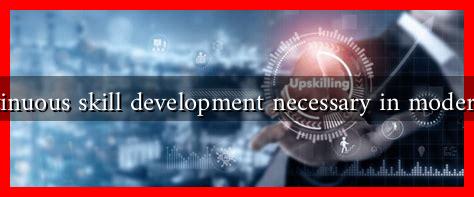-
Table of Contents
- Why is Continuous Skill Development Necessary in Modern Industries?
- The Rapid Pace of Technological Change
- Benefits of Continuous Skill Development
- Challenges to Continuous Skill Development
- Real-World Examples of Successful Skill Development Initiatives
- The Role of Online Learning Platforms
- Conclusion
Why is Continuous Skill Development Necessary in Modern Industries?
In today’s fast-paced and ever-evolving industrial landscape, the need for continuous skill development has never been more critical. As technology advances and market demands shift, organizations must ensure that their workforce is equipped with the latest skills and knowledge. This article explores the importance of continuous skill development in modern industries, highlighting its benefits, challenges, and real-world examples.
The Rapid Pace of Technological Change
One of the primary drivers of the need for continuous skill development is the rapid pace of technological change. Industries are increasingly adopting new technologies, from artificial intelligence (AI) to automation and data analytics. According to a report by the World Economic Forum, it is estimated that by 2025, 85 million jobs may be displaced by a shift in labor between humans and machines, while 97 million new roles may emerge that are more adapted to the new division of labor between humans, machines, and algorithms.
Benefits of Continuous Skill Development
Investing in continuous skill development offers numerous benefits for both employees and organizations:
- Enhanced Employee Performance: Regular training and skill enhancement lead to improved job performance, as employees become more adept at using new tools and technologies.
- Increased Employee Satisfaction: Opportunities for growth and development contribute to higher job satisfaction, reducing turnover rates and fostering a positive workplace culture.
- Competitive Advantage: Organizations that prioritize skill development are better positioned to adapt to market changes, innovate, and maintain a competitive edge.
- Future-Proofing the Workforce: Continuous learning helps employees stay relevant in their fields, ensuring they can navigate the evolving job market.
Challenges to Continuous Skill Development
Despite its importance, several challenges can hinder effective skill development:
- Resource Allocation: Organizations may struggle to allocate sufficient time and budget for training programs.
- Resistance to Change: Employees may be resistant to new training initiatives, especially if they feel overwhelmed by their current workload.
- Identifying Relevant Skills: With the rapid evolution of technology, it can be challenging for organizations to identify which skills are most relevant for their workforce.
Real-World Examples of Successful Skill Development Initiatives
Several companies have successfully implemented continuous skill development programs, showcasing the positive impact on their workforce and overall business performance:
- Amazon: The e-commerce giant has invested over $700 million in employee training programs, including upskilling initiatives that prepare workers for higher-paying jobs in technology and management.
- AT&T: Facing the challenge of rapid technological change, AT&T launched a program called “AT&T University,” which offers employees access to a wide range of courses and training opportunities to develop new skills.
- Google: Google’s “Career Certificates” program provides online courses that help individuals gain skills in high-demand fields such as data analytics and project management, demonstrating a commitment to workforce development.
The Role of Online Learning Platforms
Online learning platforms have revolutionized the way employees can access training and development resources. Platforms like Coursera, Udacity, and LinkedIn Learning offer a plethora of courses that cater to various industries and skill levels. These platforms provide flexibility, allowing employees to learn at their own pace while balancing work commitments. For more information on online learning opportunities, visit Coursera.
Conclusion
In conclusion, continuous skill development is not just a trend but a necessity in modern industries. As technology continues to evolve and reshape the job market, organizations must prioritize the ongoing education and training of their workforce. By investing in skill development, companies can enhance employee performance, increase job satisfaction, and maintain a competitive edge. While challenges exist, the benefits far outweigh the obstacles, making continuous skill development a critical component of organizational success in the 21st century.

